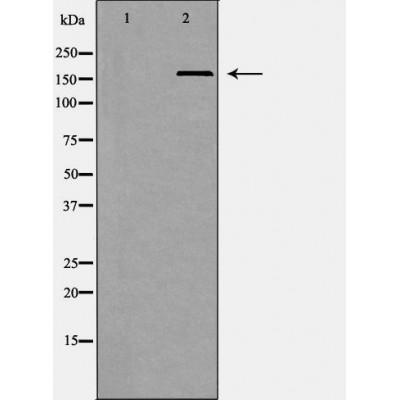BRG1 Antibody - #DF6841
| Product: | BRG1 Antibody |
| Catalog: | DF6841 |
| Description: | Rabbit polyclonal antibody to BRG1 |
| Application: | WB IHC |
| Reactivity: | Human, Mouse, Rat |
| Prediction: | Pig, Bovine, Horse, Sheep, Rabbit, Dog |
| Mol.Wt.: | 185-220kDa; 185kD(Calculated). |
| Uniprot: | P51532 |
| RRID: | AB_2838800 |
Related Downloads
Protocols
Product Info
*The optimal dilutions should be determined by the end user. For optimal experimental results, antibody reuse is not recommended.
*Tips:
WB: For western blot detection of denatured protein samples. IHC: For immunohistochemical detection of paraffin sections (IHC-p) or frozen sections (IHC-f) of tissue samples. IF/ICC: For immunofluorescence detection of cell samples. ELISA(peptide): For ELISA detection of antigenic peptide.
Cite Format: Affinity Biosciences Cat# DF6841, RRID:AB_2838800.
Fold/Unfold
ATP dependent helicase SMARCA4; ATP-dependent helicase SMARCA4; BAF 190; BAF190; BAF190A; Brahma protein like 1; BRG1; BRG1 associated factor 190A; BRG1 protein; BRG1-associated factor 190A; BRM/SWI2 related gene 1; Global transcription activator homologous sequence; global transcription activator snf2l4; Homeotic gene regulator; hSNF2b; Mitotic growth and transcription activator; MRD16; Nuclear protein GRB1; Protein brahma homolog 1; Protein BRG-1; Protein BRG1; RTPS2; SMARC A4; SMARCA4; SMCA4_HUMAN; SNF2; SNF2 beta; SNF2 like 4; SNF2-beta; SNF2B; SNF2L4; SNF2LB; Sucrose nonfermenting like 4; SWI/SNF related matrix associated actin dependent regulator of chromatin subfamily A member 4; SWI/SNF related, matrix associated, actin dependent regulator of chromatin, subfamily a, member 4; SWI/SNF-related matrix-associated actin-dependent regulator of chromatin subfamily A member 4; SWI2; Transcription activator BRG1;
Immunogens
A synthesized peptide derived from human BRG1, corresponding to a region within N-terminal amino acids.
Colocalizes with ZEB1 in E-cadherin-negative cells from established lines, and stroma of normal colon as well as in de-differentiated epithelial cells at the invasion front of colorectal carcinomas (at protein level).
- P51532 SMCA4_HUMAN:
- Protein BLAST With
- NCBI/
- ExPASy/
- Uniprot
MSTPDPPLGGTPRPGPSPGPGPSPGAMLGPSPGPSPGSAHSMMGPSPGPPSAGHPIPTQGPGGYPQDNMHQMHKPMESMHEKGMSDDPRYNQMKGMGMRSGGHAGMGPPPSPMDQHSQGYPSPLGGSEHASSPVPASGPSSGPQMSSGPGGAPLDGADPQALGQQNRGPTPFNQNQLHQLRAQIMAYKMLARGQPLPDHLQMAVQGKRPMPGMQQQMPTLPPPSVSATGPGPGPGPGPGPGPGPAPPNYSRPHGMGGPNMPPPGPSGVPPGMPGQPPGGPPKPWPEGPMANAAAPTSTPQKLIPPQPTGRPSPAPPAVPPAASPVMPPQTQSPGQPAQPAPMVPLHQKQSRITPIQKPRGLDPVEILQEREYRLQARIAHRIQELENLPGSLAGDLRTKATIELKALRLLNFQRQLRQEVVVCMRRDTALETALNAKAYKRSKRQSLREARITEKLEKQQKIEQERKRRQKHQEYLNSILQHAKDFKEYHRSVTGKIQKLTKAVATYHANTEREQKKENERIEKERMRRLMAEDEEGYRKLIDQKKDKRLAYLLQQTDEYVANLTELVRQHKAAQVAKEKKKKKKKKKAENAEGQTPAIGPDGEPLDETSQMSDLPVKVIHVESGKILTGTDAPKAGQLEAWLEMNPGYEVAPRSDSEESGSEEEEEEEEEEQPQAAQPPTLPVEEKKKIPDPDSDDVSEVDARHIIENAKQDVDDEYGVSQALARGLQSYYAVAHAVTERVDKQSALMVNGVLKQYQIKGLEWLVSLYNNNLNGILADEMGLGKTIQTIALITYLMEHKRINGPFLIIVPLSTLSNWAYEFDKWAPSVVKVSYKGSPAARRAFVPQLRSGKFNVLLTTYEYIIKDKHILAKIRWKYMIVDEGHRMKNHHCKLTQVLNTHYVAPRRLLLTGTPLQNKLPELWALLNFLLPTIFKSCSTFEQWFNAPFAMTGEKVDLNEEETILIIRRLHKVLRPFLLRRLKKEVEAQLPEKVEYVIKCDMSALQRVLYRHMQAKGVLLTDGSEKDKKGKGGTKTLMNTIMQLRKICNHPYMFQHIEESFSEHLGFTGGIVQGLDLYRASGKFELLDRILPKLRATNHKVLLFCQMTSLMTIMEDYFAYRGFKYLRLDGTTKAEDRGMLLKTFNEPGSEYFIFLLSTRAGGLGLNLQSADTVIIFDSDWNPHQDLQAQDRAHRIGQQNEVRVLRLCTVNSVEEKILAAAKYKLNVDQKVIQAGMFDQKSSSHERRAFLQAILEHEEQDESRHCSTGSGSASFAHTAPPPAGVNPDLEEPPLKEEDEVPDDETVNQMIARHEEEFDLFMRMDLDRRREEARNPKRKPRLMEEDELPSWIIKDDAEVERLTCEEEEEKMFGRGSRHRKEVDYSDSLTEKQWLKAIEEGTLEEIEEEVRQKKSSRKRKRDSDAGSSTPTTSTRSRDKDDESKKQKKRGRPPAEKLSPNPPNLTKKMKKIVDAVIKYKDSSSGRQLSEVFIQLPSRKELPEYYELIRKPVDFKKIKERIRNHKYRSLNDLEKDVMLLCQNAQTFNLEGSLIYEDSIVLQSVFTSVRQKIEKEDDSEGEESEEEEEGEEEGSESESRSVKVKIKLGRKEKAQDRLKGGRRRPSRGSRAKPVVSDDDSEEEQEEDRSGSGSEED
Predictions
Score>80(red) has high confidence and is suggested to be used for WB detection. *The prediction model is mainly based on the alignment of immunogen sequences, the results are for reference only, not as the basis of quality assurance.
High(score>80) Medium(80>score>50) Low(score<50) No confidence
Research Backgrounds
Involved in transcriptional activation and repression of select genes by chromatin remodeling (alteration of DNA-nucleosome topology). Component of SWI/SNF chromatin remodeling complexes that carry out key enzymatic activities, changing chromatin structure by altering DNA-histone contacts within a nucleosome in an ATP-dependent manner. Component of the CREST-BRG1 complex, a multiprotein complex that regulates promoter activation by orchestrating the calcium-dependent release of a repressor complex and the recruitment of an activator complex. In resting neurons, transcription of the c-FOS promoter is inhibited by SMARCA4-dependent recruitment of a phospho-RB1-HDAC repressor complex. Upon calcium influx, RB1 is dephosphorylated by calcineurin, which leads to release of the repressor complex. At the same time, there is increased recruitment of CREBBP to the promoter by a CREST-dependent mechanism, which leads to transcriptional activation. The CREST-BRG1 complex also binds to the NR2B promoter, and activity-dependent induction of NR2B expression involves the release of HDAC1 and recruitment of CREBBP. Belongs to the neural progenitors-specific chromatin remodeling complex (npBAF complex) and the neuron-specific chromatin remodeling complex (nBAF complex). During neural development, a switch from a stem/progenitor to a postmitotic chromatin remodeling mechanism occurs as neurons exit the cell cycle and become committed to their adult state. The transition from proliferating neural stem/progenitor cells to postmitotic neurons requires a switch in subunit composition of the npBAF and nBAF complexes. As neural progenitors exit mitosis and differentiate into neurons, npBAF complexes which contain ACTL6A/BAF53A and PHF10/BAF45A, are exchanged for homologous alternative ACTL6B/BAF53B and DPF1/BAF45B or DPF3/BAF45C subunits in neuron-specific complexes (nBAF). The npBAF complex is essential for the self-renewal/proliferative capacity of the multipotent neural stem cells. The nBAF complex along with CREST plays a role regulating the activity of genes essential for dendrite growth. SMARCA4/BAF190A may promote neural stem cell self-renewal/proliferation by enhancing Notch-dependent proliferative signals, while concurrently making the neural stem cell insensitive to SHH-dependent differentiating cues (By similarity). Acts as a corepressor of ZEB1 to regulate E-cadherin transcription and is required for induction of epithelial-mesenchymal transition (EMT) by ZEB1. Binds via DLX1 to enhancers located in the intergenic region between DLX5 and DLX6 and this binding is stabilized by the long non-coding RNA (lncRNA) Evf2 (By similarity). Binds to RNA in a promiscuous manner (By similarity). Binding to RNAs including lncRNA Evf2 leads to inhibition of SMARCA4 ATPase and chromatin remodeling activities (By similarity).
Nucleus.
Note: Colocalizes with long non-coding RNA Evf2 in nuclear RNA clouds.
Colocalizes with ZEB1 in E-cadherin-negative cells from established lines, and stroma of normal colon as well as in de-differentiated epithelial cells at the invasion front of colorectal carcinomas (at protein level).
Belongs to the SNF2/RAD54 helicase family.
Research Fields
· Human Diseases > Cancers: Specific types > Hepatocellular carcinoma. (View pathway)
Restrictive clause
Affinity Biosciences tests all products strictly. Citations are provided as a resource for additional applications that have not been validated by Affinity Biosciences. Please choose the appropriate format for each application and consult Materials and Methods sections for additional details about the use of any product in these publications.
For Research Use Only.
Not for use in diagnostic or therapeutic procedures. Not for resale. Not for distribution without written consent. Affinity Biosciences will not be held responsible for patent infringement or other violations that may occur with the use of our products. Affinity Biosciences, Affinity Biosciences Logo and all other trademarks are the property of Affinity Biosciences LTD.
